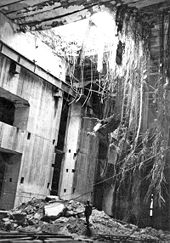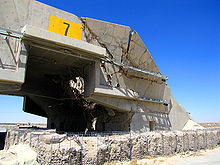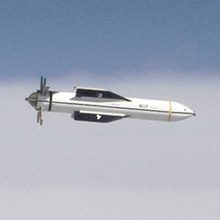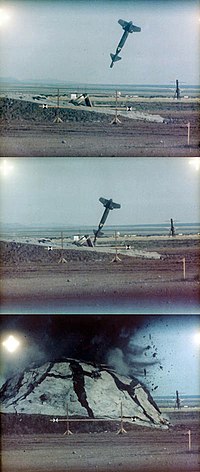

This article includes a list of general references, but it lacks sufficient corresponding inline citations. Please help to improve this article by introducing more precise citations. (August 2013) (Learn how and when to remove this message)
|
This article's use of external links may not follow Wikipedia's policies or guidelines. Please improve this article by removing excessiveorinappropriate external links, and converting useful links where appropriate into footnote references. (January 2023) (Learn how and when to remove this message)
|
Abunker buster is a type of munition that is designed to penetrate hardened targets or targets buried deep underground, such as military bunkers.
Röchling shells were bunker-busting artillery shells, developed by the German engineer August Coenders, based on the theory of increasing sectional density to improve penetration. They were tested in 1942 and 1943 against the Belgian Fort d'Aubin-Neufchâteau.[1]
In World War II the Luftwaffe developed a series of unguided rocket-propelled armor-piercing bombs for use against shipping and fortifications.


InWorld War II, the British designer Barnes Wallis, already famous for inventing the bouncing bomb, designed two bombs that would become the conceptual predecessors of modern bunker busters: the five tonne Tallboy and the ten tonne Grand Slam. These were "Earthquake" bombs—a concept he had first proposed in 1939.[3] The designs were very aerodynamic, allowing them to exceed the speed of sound as they fell from 22,000 ft (6,700 m). The tails were designed with offset fins causing the bombs to spin as they fell. Using the same principle as a spinning top, this enabled them to resist being deflected, thereby improving accuracy. They had casings of high grade steel, much stronger than the typical World War II bomb so that they would survive hitting a hardened surface, or penetrate deep into the ground.
Though these bombs might be thought of as "bunker busters" today, in fact the original "earthquake" theory was more complex and subtle than simply penetrating a hardened surface. The earthquake bombs were designed not to strike a target directly, but to impact beside it, penetrate under it, and create a 'camouflet', or large buried cavern, at the same time as delivering a shock wave through the target's foundations. The target then collapses into the hole, no matter how hardened it may be. The bombs had strong casings because they needed to travel through rock rather than reinforced concrete, though they could perform equally well against hardened surfaces. In an attack on the Valentin U-Boat pensatFarge, two Grand Slams went through the 15 ft (4.5 m) reinforced concrete hardening[4]—equalling or exceeding the best current penetration specifications.
The British Disney bomb (officially "4500 lb Concrete Piercing/Rocket Assisted bomb") was a World War II device designed to be used against U-boat pens and other super-hardened targets. Devised by Captain Edward Terrell RNVR of the Admiralty's Directorate of Miscellaneous Weapons Development,[5] it had a streamlined hardened case and weighed about 4,500 lb (2,000 kg) including the rocket assembly. The actual explosive content was about 500 lb (230 kg).
For accuracy, the bombs had to be dropped precisely from a pre-determined height (usually 20,000 ft (6,100 m)).[6] They would free-fall for around 30 seconds until, at 5,000 ft (1,500 m), the rockets were ignited, causing the tail section to be expelled.[6] The rocket burn lasted for three seconds[7] and added 300 ft/s (91 m/s) to the bomb's speed, giving a final impact speed of 1,450 ft/s (440 m/s; 990 mph),[7] approximately Mach 1.29.[a] Post-war tests demonstrated that the bombs were able to penetrate a 14-foot-8-inch (4.47 m) thick concrete roof,[8] with the predicted (but untested) ability to penetrate 16 feet 8 inches (5.08 m) of concrete.[8]
Post war, the US added a form of remote guidance to the Tallboy to create the Tarzon, a 12,000-pound bomb (5,443 kg) deployed in the Korean War against an underground command center near Kanggye.

During Operation Desert Storm (1991), there was a need for a deep penetration bomb similar to the British weapons of World War II, but none of the NATO air forces had such a weapon. As a stop-gap, some were developed over a period of 28 days, using old 8 inch (203 mm) artillery barrels as casings. These bombs weighed over two tons but carried only 647 lb (293 kg) of high explosive. They were laser-guided and were designated "Guided Bomb Unit-28 (GBU-28)". It was proven effective for the intended role.[9]
An example of a Russian bunker buster is the KAB-1500L-Pr. It is delivered with the Su-24M and the Su-34 aircraft. It is stated to be able to penetrate 10–20 m of earth or 2 m of reinforced concrete. The bomb weighs 1,500 kg (3,300 lb), with 1,100 kg (2,400 lb) being the high explosive penetrating warhead. It is laser guided and has a reported strike accuracy of 7 m (23 ft) CEP.[10]
The US has a series of custom made bombs such as the Paveway series of laser-guided bombs to penetrate hardened or deeply buried structures :
| Depth of Penetration reinforced concrete |
Weapon Systems | |
|---|---|---|
| 1.8 m (6 ft) | BLU-109 Penetrator | GBU-10, GBU-15, GBU-24, GBU-27, AGM-130 |
| 3.4 m (11 ft) | BLU-116 Advanced Unitary Penetrator (AUP) | GBU-15, GBU-24, GBU-27, AGM-130 |
| BLU-118/B Thermobaric Warhead | GBU-15, GBU-24, AGM-130 | |
| more than 6 m (20 ft) | BLU-113 Super Penetrator | GBU-28, GBU-37 |
More recently, the US has developed the 30,000-pound GBU-57.
Turkey is another country known to be developing bunker busters, such as the SARB-83 and NEB-84.

The traditional fuze is the same as a classic armor-piercing bomb: a combination of timer and a sturdy dynamic propeller on the rear of the bomb. The fuze is armed when the bomb is released, and detonates when the propeller stops turning and the timer has expired.
Modern bunker busters may use a traditional fuze, but some also include a microphone and microcontroller. The microphone listens, and the microcontroller counts the number of floors until the bomb breaks through the desired numbers of floors. Northrop Grumman is working on the Hard Target Void Sensing Fuze (HTVSF) ,an electronic, cockpit programmable, fuze capable of destroying deeply buried and targets. It provides multiple delay arming and detonation times, as well as a void-sensing capability, which allows for precision activation of the fuze for 2,000-and-5,000-pound (910 and 2,270 kg) weapons to explode when they reach an open space in a deeply buried bunker.[11] [12]

The extra speed provided by a rocket motor enables greater penetration of a missile-mounted bunker buster warhead. To reach maximum penetration (impact depth), the warhead may consist of a high-density projectile only. Such a warhead carries more energy than a warhead with chemical explosives (kinetic energy of a projectile at hypervelocity).
The nuclear bunker buster is the nuclear weapon version of the bunker buster. The non-nuclear component of the weapon is designed to greatly enhance the penetration into soil, rock, or concrete to deliver a nuclear warhead to a target. These weapons would be used to destroy hardened, underground military bunkers deeply buried. In theory, the amount of radioactive nuclear fallout would be reduced from that of a standard, air-burst nuclear detonation because they would have relatively low explosive yield. However, because such weapons necessarily come into contact with large amounts of earth-based debris, they may, under certain circumstances, still generate significant fallout. Warhead yield and weapon design have changed periodically throughout the history of the design of such weapons. An underground explosion releases a larger fraction of its energy into the ground, compared to an explosion at or above the surface which releases most of its energy into the atmosphere.
This is a standalone report documenting the latest version of the Young/Sandia penetration equations and related analytical techniques to predict penetration into natural earth materials and concrete.